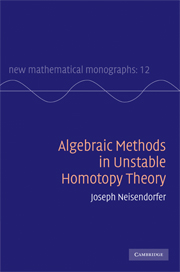Book contents
- Frontmatter
- Contents
- Preface
- Acknowledgments
- Introduction to unstable homotopy theory
- 1 Homotopy groups with coefficients
- 2 A general theory of localization
- 3 Fibre extensions of squares and the Peterson–Stein formula
- 4 Hilton–Hopf invariants and the EHP sequence
- 5 James–Hopf invariants and Toda–Hopf invariants
- 6 Samelson products
- 7 Bockstein spectral sequences
- 8 Lie algebras and universal enveloping algebras
- 9 Applications of graded Lie algebras
- 10 Differential homological algebra
- 11 Odd primary exponent theorems
- 12 Differential homological algebra of classifying spaces
- Bibliography
- Index
5 - James–Hopf invariants and Toda–Hopf invariants
Published online by Cambridge University Press: 03 May 2010
- Frontmatter
- Contents
- Preface
- Acknowledgments
- Introduction to unstable homotopy theory
- 1 Homotopy groups with coefficients
- 2 A general theory of localization
- 3 Fibre extensions of squares and the Peterson–Stein formula
- 4 Hilton–Hopf invariants and the EHP sequence
- 5 James–Hopf invariants and Toda–Hopf invariants
- 6 Samelson products
- 7 Bockstein spectral sequences
- 8 Lie algebras and universal enveloping algebras
- 9 Applications of graded Lie algebras
- 10 Differential homological algebra
- 11 Odd primary exponent theorems
- 12 Differential homological algebra of classifying spaces
- Bibliography
- Index
Summary
We begin this chapter by introducing the important concept of a divided power algebra. Divided power algebras arise in the description of the cohomology algebras of several important spaces, among them loops on spheres. These algebras have interesting properties when localized at primes. In particular, these properties give rise to Hopf invariants of two types. The first type is due to James and Hilton. The second type is due to Toda.
The James construction allows two definitions of Hopf invariants. The so-called combinatorial definition is probably the simplest and most attractive. Another one, the so-called decomposition definition, is based on James' natural splitting of the suspension of the James construction.
As we have seen in the previous chapter, the Hilton–Milnor theorem leads to the Hilton–Hopf invariants. Certain Lie identities are required to control the homological properties of the Hilton–Hopf invariants.
These three constructions of Hopf invariants are for the most part interchangeable for all practical purposes (although the Hilton–Hopf invariants are more tractable concerning the issues which arise in the 2-primary exponent theorem for the homotopy groups of spheres). The most important properties which they share are the homological properties necessary to construct the James fibrations and the p-adic naturality which is used in the proof of exponent theorems.
Localized at odd primes, the James fibrations involve filtrations of the James constructions. The homology of the loops on these filtrations was first studied by Toda.
- Type
- Chapter
- Information
- Algebraic Methods in Unstable Homotopy Theory , pp. 135 - 157Publisher: Cambridge University PressPrint publication year: 2010



